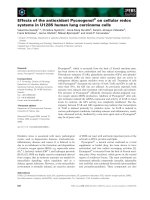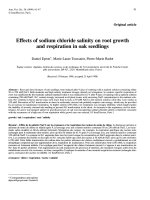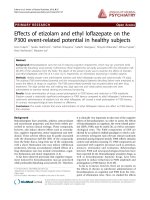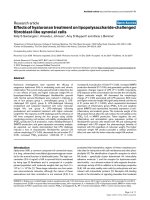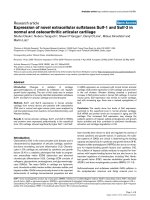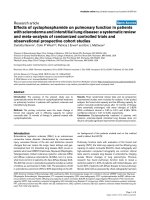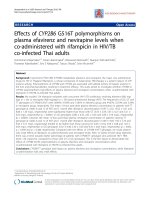Báo cáo y học: "Effects of interventional lung assist on haemodynamics and gas exchange in cardiopulmonary resuscitation: a prospective experimental study on animals with acute respiratory distress syndrome" pdf
Bạn đang xem bản rút gọn của tài liệu. Xem và tải ngay bản đầy đủ của tài liệu tại đây (269.95 KB, 6 trang )
Open Access
Available online />Page 1 of 6
(page number not for citation purposes)
Vol 13 No 1
Research
Effects of interventional lung assist on haemodynamics and gas
exchange in cardiopulmonary resuscitation: a prospective
experimental study on animals with acute respiratory distress
syndrome
Günther Zick, Dirk Schädler, Gunnar Elke, Sven Pulletz, Berthold Bein, Jens Scholz, Inéz Frerichs
and Norbert Weiler
Department of Anesthesiology and Intensive Care Medicine, University Medical Center Schleswig-Holstein, Campus Kiel, Arnold-Heller-Straße 3, D-
24105 Kiel, Germany
Corresponding author: Günther Zick,
Received: 19 Sep 2008 Revisions requested: 27 Sep 2008 Revisions received: 20 Jan 2009 Accepted: 11 Feb 2009 Published: 11 Feb 2009
Critical Care 2009, 13:R17 (doi:10.1186/cc7716)
This article is online at: />© 2009 Zick et al.; licensee BioMed Central Ltd.
This is an open access article distributed under the terms of the Creative Commons Attribution License ( />),
which permits unrestricted use, distribution, and reproduction in any medium, provided the original work is properly cited.
Abstract
Introduction Interventional lung assist (ILA), based on the use
of a pumpless extracorporeal membrane oxygenator, facilitates
carbon dioxide (CO
2
) elimination in acute respiratory distress
syndrome (ARDS). It is unclear whether an ILA system should
be clamped during cardiopulmonary resuscitation (CPR) in
patients with ARDS or not. The aim of our study was to test the
effects of an ILA on haemodynamics and gas exchange during
CPR on animals with ARDS and to establish whether the ILA
should be kept open or clamped under these circumstances.
Methods The study was designed to be prospective and
experimental. The experiments were performed on 12
anaesthetised and mechanically ventilated pigs (weighing 41 to
58 kg). One femoral artery and one femoral vein were
cannulated and connected to an ILA. ARDS was induced by
repeated bronchoalveolar lavage. An indwelling pacemaker was
used to initiate ventricular fibrillation and chest compressions
were immediately started and continued for 30 minutes. In six
animals, the ILA was kept open and in the other six it was
clamped.
Results Systolic and mean arterial pressures did not differ
significantly between the groups. With the ILA open mean ±
standard deviation systolic blood pressures were 89 ± 26
mmHg at 5 minutes, 71 ± 28 mmHg at 10 minutes, 63 ± 33
mmHg at 20 minutes and 83 ± 23 mmHg at 30 minutes. The
clamped ILA system resulted in systolic pressures of 77 ± 30
mmHg, 90 ± 23 mmHg, 72 ± 11 mmHg and 72 ± 22 mmHg,
respectively. In the group with the ILA system open, arterial
partial pressure of CO
2
was significantly lower after 10, 20 and
30 minutes of CPR and arterial partial pressure of oxygen was
higher 20 minutes after the onset of CPR (191 ± 140 mmHg
versus 57 ± 14 mmHg). End-tidal partial pressure of CO
2
decreased from 46 ± 23 Torr (ILA open) and 37 ± 9 Torr (ILA
clamped) before intervention to 8 ± 5 Torr and 8 ± 10 Torr,
respectively, in both groups after 30 minutes of CPR.
Conclusions Our results indicate that in an animal model of
ARDS, blood pressures were not impaired by keeping the ILA
system open during CPR compared with the immediate
clamping of the ILA with the onset of CPR. The effect of ILA on
gas exchange implied a beneficial effect.
Introduction
Interventional Lung Assist (ILA) describes a technique, which
uses a pumpless arteriovenous extracorporeal membrane oxy-
genator to facilitate carbon dioxide (CO
2
) removal. Its ability to
remove CO
2
has been well demonstrated [1-6]. The aim of the
extracorporeal CO
2
elimination by the ILA system is to
decrease the minute ventilation and the peak inspiratory pres-
sure and thereby reduce the risk of barotrauma associated
with mechanical ventilation in patients with acute respiratory
distress syndrome (ARDS).
ARDS: acute respiratory distress syndrome; CO
2
: carbon dioxide; CPR: cardiopulmonary resuscitation; CPP: coronary perfusion pressure; CVP: cen-
tral venous pressure; FiO
2
: inspired fraction of oxygen; ILA: interventional lung assist; O
2
: oxygen; PaCO
2
: arterial partial pressure of carbon dioxide;
PaO
2
: arterial partial pressure of oxygen; PCO
2
: partial pressure of carbon dioxide; PEEP: positive end-expiratory pressure; PV: pressure volume.
Critical Care Vol 13 No 1 Zick et al.
Page 2 of 6
(page number not for citation purposes)
The effect of ILA on oxygenation remains unclear [7-11]. In
contrast to a veno-venous extracorporeal membrane oxygena-
tion the effect on oxygenation is limited because in the setting
of an arteriovenous shunt, oxygen (O
2
) provided by the ILA
system is added to the arterial blood where the saturation is
already relatively high. In a previous study in a non-arrest
model, we found a significant but only small effect of ILA on
arterial partial pressure of O
2
(PaO
2
) [12].
An effective operation of the ILA system relies on an arteriov-
enous shunt and for that reason a patient is required to have
stable circulation because the blood pressure of the patient is
the driving force of the device. If cardiopulmonary resuscitation
(CPR) is performed in a patient treated with ILA for ARDS not
only does the cardiac arrest have to be dealt with but also the
severely impaired gas exchange and usually high levels of pos-
itive end-expiratory pressure (PEEP). In such a situation we
found it difficult to decide whether to leave the ILA system
open to take advantage of the beneficial effects described
above or to clamp it and avoid the shunt with its potentially
harmful effects on circulation. This has not yet been examined,
so we set up an experimental model as close to the clinical sit-
uation as possible to study this effect.
Our hypothesis was that in CPR the ILA system had no signif-
icant effect on gas exchange (PaO
2
and arterial partial pres-
sure of CO
2
(PaCO
2
)) and a harmful effect on circulation
(coronary perfusion pressure (CPP), systolic arterial pressure
and mean arterial pressure).
The primary study end points were the CPP for haemodynamic
stability and PaO
2
and PaCO
2
for gas exchange. Secondary
study end points were systolic and mean arterial pressures,
end-tidal partial pressure of CO
2
(PCO
2
), flow through the ILA
system and return of spontaneous circulation.
Materials and methods
The study was approved by the Committee for Animal Care of
the Christian Albrechts University, Kiel, Germany, and adhered
to the guidelines on animal experimentation. The experiments
were performed on 12 domestic pigs (Deutsches Landsch-
wein; Institute of Animal Breeding and Husbandry, Christian
Albrechts University, Kiel, Germany) with a body weight of 41
to 58 kg. After premedication with azaperon (8 mg/kg (stres-
nil
®
; Janssen Cilag, Neuss, Germany)) and atropin (0.1 mg/kg
(atropinsulfat
®
; B. Braun, Melsungen, Germany)) anaesthesia
was induced with ketamine (5 mg/kg (ketanest
®
S; Pfizer, Ber-
lin, Germany)), sufentanil (0.2 μg/kg (sufenta
®
; Janssen Cilag,
Germany)) and propofol (1 mg/kg (propofol-
®
Lipuro 2%; B.
Braun, Melsungen, Germany)). Intubation and controlled ven-
tilation with an inspired fraction of oxygen (FiO
2
) of 100%
were performed (Siemens servo 900c ventilator, Siemens-
Elema, Solna, Sweden). Anaesthesia was continued with pro-
pofol (6 to 8 mg/kg per hour) and sufentanil (10 μg/kg per
hour). Lactated Ringer's solution was infused at a rate of 20
ml/kg per hour.
The carotid artery was cannulated and this line was used to
draw arterial blood samples. The samples were processed by
a blood gas analyser (ABL System 615, Radiometer Medical
Inc., Copenhagen, Denmark). The internal jugular vein was
cannulated and a catheter inserted for measurement of the
central venous pressure (CVP). The contralateral internal jug-
ular vein provided access for the placement of a pacemaker
electrode. A 7 Fr pulmonary artery catheter (Arrow Interna-
tional, Everett, MA, USA) was inserted through the iliac artery
into the thoracic descending aorta for measurement of blood
pressure. PCO
2
in respired gas, airway pressures, arterial
venous pressure and CVP were monitored using the S/5
anaesthesia monitoring system (Datex Ohmeda, Helsinki, Fin-
land).
The iliac artery and vein were cannulated with ultrasound guid-
ance and a 13 Fr cannula was inserted into the artery and a 15
Fr cannula into the vein using Seldinger's technique. The ILA
device (Novalung, Hechingen, Germany) was filled with saline
solution and connected with these two cannulae, thereby gen-
erating the arteriovenous shunt required for the intended gas
exchange. Five thousand units of heparin were given after the
instrumentation was completely set up and the extracorporeal
flow was started without oxygen flow at that time.
Acute lung injury was then induced with repeated bronchoal-
veolar lavages with warm saline solution, 1.5 L each. They
were performed until PaO
2
remained stable below 100 Torr
with an FiO
2
of 100% and PEEP of 5 cmH
2
O for 30 minutes.
Having achieved stable lung injury, oxygen flow through the
ILA device was commenced with 10 L/minute. A low flow
pressure volume (PV) manoeuvre using a slow inflation up to
30 cmH
2
O was then performed. It showed lower inflection
points of more than 20 cmH
2
O indicating that PEEP values at
or slightly above that level were required. Because no data
exist on the best PEEP level in patients with ARDS during
CPR, we chose to avoid PEEP in that high range and set PEEP
arbitrarily to 12 cmH
2
O as a compromise. Ventilation was per-
formed in the volume-controlled mode with a tidal volume of 10
ml/kg and the rate set to achieve normal arterial CO
2
tension.
A fibrillator (Fibrillator Fi 10 M, Stöckert Instrumente,
München, Germany) was then connected with the indwelling
pacemaker and ventricular fibrillation was induced with the
application of 10 V. Manual chest compressions were started
without delay and continued for 30 minutes. In six animals, the
ILA system was clamped immediately; in the other group of six
animals it remained open. Adrenaline was administered as a
continuous infusion at a rate of 1 μg/kg/minute with additional
boluses of 1 or 3 mg if the mean blood pressure fell below 50
mmHg to ensure sufficient blood pressure and, therefore,
Available online />Page 3 of 6
(page number not for citation purposes)
CPP. Blood samples were drawn before fibrillation and at 5,
10, 20 and 30 minutes after onset of resuscitation. Arterial
blood pressures and CVP were continuously recorded with a
sampling rate of 300 Hz (ICUpilot, version 2.0, CMA/Microdi-
alysis, Solna, Sweden). End-tidal PCO
2
and flow through the
ILA system were registered at 5, 10, 20 and 30 minutes. The
chest compressions were stopped after 30 minutes and defi-
brillation was performed with 300 Joule (Lifepak 12, Physio-
control, Medtronic, Redmond, WA, USA). Restoration of
spontaneous circulation was intended. In cases where it was
not successful after three attempts, no further resuscitation
was performed.
Statistical analysis
The results are presented as mean values ± standard devia-
tions. Statistical analysis was performed using GraphPad
Prism version 4.03 for Windows (GraphPad Software, San
Diego, CA, USA). Two-way analysis of variance followed by
the Bonferroni multiple comparison test was applied to test
the significance of differences between the measurements.
Statistical significance was accepted at p < 0.05. The
reported P values are two-tailed.
Results
Before initiation of resuscitation all animals had a severe lung
injury and a stable haemodynamic situation with a systolic arte-
rial blood pressure of 113 ± 13 mmHg in the group in which
ILA would be kept open and 117 ± 11 mmHg in the group that
would have ILA clamped. The corresponding mean arterial
pressures were 89 ± 7 mmHg and 77 ± 8 mmHg, respec-
tively. These blood pressures generated a flow through ILA of
1.7 ± 0.3 L/minute. After lung injury, PaO
2
in the open group
stabilised at a level of 123 ± 25 Torr and 124 ± 37 Torr in the
other group.
Performing the PV manoeuvre after the induction of ARDS and
before CPR showed lower inflection points of 19 ± 5 cmH
2
O.
Setting the PEEP 2 cmH
2
O above the respective lower inflec-
tion point resulted in an increase of PaO
2
to 430 ± 106 Torr
and 407 ± 132 Torr in the two groups. After reduction of
PEEP to 12 mmHg before initiating circulatory arrest and
CPR, PaO
2
fell to 132 ± 26 Torr and 133 ± 31 Torr (Figure 1).
When we tried to determine the CVP and hence the CPP dur-
ing offline analysis, we found that the interpretation could not
be performed reliably because of artefacts in the CVP read-
ings caused by the chest compression during CPR.
PaCO
2
was significantly lower in the group with the ILA sys-
tem open (Figure 2). PaO
2
was higher in this group, however,
the difference was only significant at 20 minutes (Figure 1).
With chest compressions and with ILA open, systolic blood
pressures of 89 ± 26 mmHg at 5 minutes, 71 ± 28 mmHg at
10 minutes, 63 ± 33 mmHg at 20 minutes and 83 ± 23 mmHg
at 30 minutes could be achieved (Figure 3). With ILA clamped,
the following pressures were determined: 77 ± 30 mmHg, 90
± 23 mmHg, 72 ± 11 mmHg and 72 ± 22 mmHg, respec-
tively. Mean blood pressures were 30 ± 7 mmHg in the group
with ILA open and 30 ± 6 mmHg in the group with ILA
clamped at five minutes, decreasing continuously to 20 ± 9
mmHg with ILA open and 19 ± 9 mmHg with ILA clamped at
30 minutes (Figure 4).
An adrenaline dose of 3.3 ± 2.7 mg in the group with ILA open
and 3.2 ± 0.8 mg in the group with ILA clamped was given at
five minutes, at 10 minutes the cumulative dose was 6.5 ± 3.3
mg and 7.5 ± 1.8 mg, and at 20 minutes 13.7 ± 7.0 mg and
13.2 ± 4.3 mg, respectively, was given. The total dose of
adrenaline after 30 minutes was about 19 mg in each group
(18.8 ± 8.6 mg with ILA open and 18.7 ± 6.2 mg with ILA
clamped). Flow through the ILA system decreased under con-
Figure 1
Arterial partial pressure of oxygen (PaO
2
) in the course of resuscitationArterial partial pressure of oxygen (PaO
2
) in the course of resuscitation.
ILA = interventional lung assist. * p < 0.05.
Figure 2
Arterial partial pressure of carbon dioxide (PaCO
2
) in the course of resuscitationArterial partial pressure of carbon dioxide (PaCO
2
) in the course of
resuscitation. ILA = interventional lung assist. * p < 0.05; ** p < 0.005.
Critical Care Vol 13 No 1 Zick et al.
Page 4 of 6
(page number not for citation purposes)
ditions of resuscitation (Figure 5). In three cases a flow
reversal was observed at the end of the observation time, seen
as a change in the blood colour at the inlet and outlet of the
ILA. At the same time, negative flow values in a range below
0.02 L/minute were detected.
Neither blood pressures nor the administered dose of adrena-
line were significantly different between the groups.
End-tidal PCO
2
decreased from 46 ± 23 Torr with ILA open
and 37 ± 9 Torr with ILA clamped before resuscitation to 8 ±
5 Torr and 8 ± 10 Torr, respectively, at the end of 30 minutes
of CPR and was not different between the groups (Figure 6).
Return of spontaneous circulation did not occur in either
group after 30 minutes of CPR.
Discussion
The use of extracorporeal lung assist is an additional therapeu-
tic approach in patients with severe ARDS that facilitates a
lung protective ventilation strategy. This is achieved mainly by
an extracorporeal CO
2
elimination and possibly sustained by a
small oxygenation effect generated by an arteriovenous shunt
through an artificial membrane.
In the case of CPR in a patient with severe ARDS and estab-
lished extracorporeal lung assist, the question arises whether
Figure 3
Systolic arterial pressure (SAP) in the course of resuscitationSystolic arterial pressure (SAP) in the course of resuscitation. ILA =
interventional lung assist.
Figure 4
Mean arterial pressure (MAP) in the course of resuscitationMean arterial pressure (MAP) in the course of resuscitation. ILA = inter-
ventional lung assist.
Figure 5
Flow through the interventional lung assist (ILA) device in the course of resuscitationFlow through the interventional lung assist (ILA) device in the course of
resuscitation.
Figure 6
End-tidal partial pressure of carbon dioxide (CO
2
) in the course of resuscitationEnd-tidal partial pressure of carbon dioxide (CO
2
) in the course of
resuscitation. ILA = interventional lung assist.
Available online />Page 5 of 6
(page number not for citation purposes)
ILA should be kept open or clamped. In such a situation the
extracorporeal lung assist may still exert its beneficial effects
on gas exchange or it may be harmful because of the arteriov-
enous shunt it causes. We have tested the effects of CPR on
circulation and gas exchange with or without an ILA device
operating in animals with ARDS.
Before initiation of resuscitation all animals had a severe
ARDS and a stable haemodynamic situation. After induction of
ventricular fibrillation chest compressions were started with-
out delay. Our primary goal was not the survival after pro-
longed ischaemia, so we did not adhere to the Utstein
Guidelines with the recommended 'non-intervention interval'
[13]. Our model was designed to resemble an ARDS patient
in an ICU. CPR would be started without delay in that setting.
We could not analyse the CVP reliably, which prevented the
intended analysis of the CPP. This was due to the fact that we
intended to analyse the CPP offline and only then recognised
the invalid CVP measurement after the experiments were com-
pleted. Therefore, we took the more robust arterial pressure
readings to assess the effects of ILA on circulation. The blood
pressure that could be generated with chest compressions
did not differ significantly between the two groups (Figures 3
and 4). End-tidal CO
2
was also in the same range (Figure 6).
Therefore, we assume that the circulation did not differ signif-
icantly and that the shunt by the ILA did not deteriorate the cir-
culation.
Because of the low arterial pressure, flow through the ILA sys-
tem decreased and fell to almost zero in the course of the 30-
minute resuscitation period (Figure 5). This is consistent with
the differences in PaCO
2
(Figure 2) and PaO
2
(Figure 1) also
occurring in the early phase of CPR and a continuously
decreasing contribution of the ILA in the further course of
CPR.
Adrenaline was administered according to the arterial blood
pressure and our goal was to keep the mean pressure above
50 mmHg according to guidelines that would be applied in a
clinical situation [14] which recommend 1 mg of adrenaline
every three to five minutes. We adjusted the dose when the
arterial pressure did not respond according to our protocol.
The response to our adrenaline therapy might have additionally
been blunted by a systemic inflammatory response syndrome
caused by repeated lung lavages.
Behringer and colleagues found that high doses of adrenaline
were associated with unfavourable neurological outcome but
restoration of spontaneous circulation was possible with
increasing cumulative doses of adrenaline. In his conclusion
he suggested that further investigations should be attempted
to better define limits for adrenaline doses during CPR [15].
The resuscitation was continued for 30 minutes without any
attempt at defibrillation. First defibrillation was performed after
30 minutes. In neither group, return of spontaneous circulation
could be established. As our intention was to examine the
effect of ILA on haemodynamics and gas exchange over a suf-
ficient time interval, we may have missed the point where an
effect on the survival may have been discernible. The main rea-
sons for the lack of survival may therefore be the long duration
of CPR, the severity of the induced lung injury and relatively
low arterial blood pressure. All animals had severe ARDS,
which may have caused a systemic inflammatory response
syndrome with impaired responsiveness to adrenaline. Red-
berg and colleagues reported arterial blood and end-tidal CO
2
pressures comparable with our data in 20 patients from whom
five were successfully resuscitated [16]. Other authors report
even lower arterial pressures and ensuing successful resusci-
tation; however, with much shorter resuscitation time and no
accompanying ARDS [17].
Another factor negatively affecting the response to attempted
defibrillation after 30 minutes of CPR was probably the rela-
tively high intrathoracic pressure. The interpretation of our low
flow PV recruitment manoeuvre would have indicated that high
PEEP levels of over 20 cmH
2
O would have been required. We
are not aware of any recommendation for PEEP setting in
patients or animals with ARDS during CPR. Therefore, we
chose to set PEEP at 12 cmH
2
O as a compromise between
derecruitment of aerated lung regions and impairment of circu-
lation. Many authors were able to demonstrate the harmful
effect of high intrathoracic pressures in CPR [18-22]. As a
consequence, Aufderheide and colleagues found increased
survival rates with reduced intrathoracic pressures in CPR
after cardiac arrest using an impedance threshold device [23].
The main limitations of our study are the missing data on the
CPP and other measures of tissue perfusion. Another limita-
tion of our study is the deliberate decision to set the PEEP
level at 12 cmH
2
O. However, no data are available at present
on how the optimal PEEP should be set in this situation.
Conclusions
The blood pressures were not impaired by keeping the ILA
system open during CPR compared with the immediate
clamping of the ILA with the onset of CPR and PaO
2
and
PaCO
2
showed a potential benefit from the open ILA system.
We therefore conclude that when in doubt the ILA system
should be kept open. We found no evidence suggesting that
ILA should be clamped. The optimal PEEP setting in CPR in
ARDS patients remains unclear and requires further studies.
Competing interests
The study was partially supported by Novalung, Hechingen,
Germany.
Critical Care Vol 13 No 1 Zick et al.
Page 6 of 6
(page number not for citation purposes)
Authors' contributions
GZ participated in design of the study, carried out the study
and drafted the manuscript. DS carried out the study and par-
ticipated in the analysis of data. GE carried out the study and
participated in the analysis of data. SP carried out the study.
BB participated in the design of the study and revised the
manuscript. JS participated in design and coordination. IF per-
formed the analysis and interpretation of the data and revised
the manuscript. NW conceived the study and participated in
the design of the study, analysis and interpretation of data and
revision of the manuscript. All authors read and approved the
final manuscript.
Acknowledgements
We acknowledge the partial financial support by Novalung, Hechingen,
Germany.
References
1. Brunston RLJ, Zwischenberger JB, Tao W, Cardenas VJJ, Traber
DL, Bidani A: Total arteriovenous CO
2
removal: simplifying
extracorporeal support for respiratory failure. Ann Thorac Surg
1997, 64:1599-604. discussion 1604–1605
2. Conrad SA, Brown EG, Grier LR, Baier J, Blount J, Heming T,
Zwischenberger JB, Bidani A: Arteriovenous extracorporeal car-
bon dioxide removal: a mathematical model and experimental
evaluation. ASAIO J 1998, 44:267-277.
3. Frank BR, Tao W, Brunston RLJ, Alpard SK, Bidani A, Zwischen-
berger JB: High flow/low resistance cannulas for percutane-
ous arteriovenous carbon dioxide removal. ASAIO J 1997,
43:M817-820.
4. Zwischenberger JB, Conrad SA, Alpard SK, Grier LR, Bidani A:
Percutaneous extracorporeal arteriovenous CO
2
removal for
severe respiratory failure. Ann Thorac Surg 1999, 68:181-187.
5. Conrad SA, Zwischenberger JB, Grier LR, Alpard SK, Bidani A:
Total extracorporeal arteriovenous carbon dioxide removal in
acute respiratory failure: a phase I clinical study. Intensive
Care Med 2001, 27:1340-1351.
6. Kolobow T, Gattinoni L, Tomlinson T, Pierce JE: An alternative to
breathing. J Thorac Cardiovasc Surg 1978, 75:261-266.
7. Bein T, Prasser C, Philipp A, Muller T, Weber F, Schlitt HJ, Schmid
FX, Taeger K, Birnbaum D: [Pumpless extracorporeal lung
assist using arterio-venous shunt in severe ARDS. Experience
with 30 cases]. Anaesthesist 2004, 53:813-819.
8. Liebold A, Reng CM, Philipp A, Pfeifer M, Birnbaum DE: Pumpless
extracorporeal lung assist – experience with the first 20 cases.
Eur J Cardiothorac Surg 2000, 17:608-613.
9. Reng M, Philipp A, Kaiser M, Pfeifer M, Gruene S, Schoelmerich J:
Pumpless extracorporeal lung assist and adult respiratory dis-
tress syndrome. Lancet 2000, 356(9225):219-220.
10. Sussmane JB, Totapally BR, Hultquist K, Torbati D, Wolfsdorf J:
Effects of arteriovenous extracorporeal therapy on hemody-
namic stability, ventilation, and oxygenation in normal lambs.
Crit Care Med 2001, 29:1972-1978.
11. Zimmermann M, Bein T, Philipp A, Ittner K, Foltan M, Drescher J,
Weber F, Schmid FX: Interhospital transportation of patients
with severe lung failure on pumpless extracorporeal lung
assist. Br J Anaesth 2006, 96:63-66.
12. Zick G, Frerichs I, Schadler D, Schmitz G, Pulletz S, Cavus E,
Wachtler F, Scholz J, Weiler N: Oxygenation effect of interven-
tional lung assist in a lavage model of acute lung injury: a pro-
spective experimental study. Crit Care 2006, 10:R56.
13. Idris AH, Becker LB, Ornato JP, Hedges JR, Bircher NG, Chandra
NC, Cummins RO, Dick W, Ebmeyer U, Halperin HR, Hazinski MF,
Kerber RE, Kern KB, Safar P, Steen PA, Swindle MM, Tsitlik JE, von
Planta I, von Planta M, Wears RL, Weil MH: Utstein-style guide-
lines for uniform reporting of laboratory CPR research. A state-
ment for healthcare professionals from a Task Force of the
American Heart Association, the American College of Emer-
gency Physicians, the American College of Cardiology, the
European Resuscitation Council, the Heart and Stroke Foun-
dation of Canada, the Institute of Critical Care Medicine, the
Safar Center for Resuscitation Research, and the Society for
Academic Emergency Medicine. Resuscitation 1996, 33:69-84.
14. Nolan JP, Deakin CD, Soar J, Bottiger BW, Smith G: European
Resuscitation Council guidelines for resuscitation 2005. Sec-
tion 4. Adult advanced life support. Resuscitation 2005,
67(Suppl 1):S39-86.
15. Behringer W, Kittler H, Sterz F, Domanovits H, Schoerkhuber W,
Holzer M, Mullner M, Laggner AN: Cumulative epinephrine dose
during cardiopulmonary resuscitation and neurologic out-
come. Ann Intern Med 1998, 129:450-456.
16. Redberg RF, Tucker KJ, Cohen TJ, Dutton JP, Callaham ML,
Schiller NB: Physiology of blood flow during cardiopulmonary
resuscitation. A transesophageal echocardiographic study.
Circulation 1993, 88:534-542.
17. Achleitner U, Wenzel V, Strohmenger HU, Lindner KH, Baubin MA,
Krismer AC, Mayr VD, Amann A: The beneficial effect of basic
life support on ventricular fibrillation mean frequency and cor-
onary perfusion pressure. Resuscitation 2001, 51:151-158.
18. Aufderheide TP, Lurie KG: Death by hyperventilation: a common
and life-threatening problem during cardiopulmonary resusci-
tation. Crit Care Med 2004, 32:S345-351.
19. Aufderheide TP, Sigurdsson G, Pirrallo RG, Yannopoulos D, McK-
nite S, von Briesen C, Sparks CW, Conrad CJ, Provo TA, Lurie KG:
Hyperventilation-induced hypotension during cardiopulmo-
nary resuscitation. Circulation 2004, 109:1960-1965.
20. De Maio VJ: The quest to improve cardiac arrest survival: Over-
coming the hemodynamic effects of ventilation. Crit Care Med
2005, 33:898-899.
21. Pepe PE, Raedler C, Lurie KG, Wigginton JG: Emergency venti-
latory management in hemorrhagic states: elemental or detri-
mental? J Trauma 2003, 54:1048-1055. discussion 1055–1057
22. Sigurdsson G, Yannopoulos D, McKnite SH, Lurie KG: Cardiores-
piratory interactions and blood flow generation during cardiac
arrest and other states of low blood flow. Curr Opin Crit Care
2003, 9:183-188.
23. Aufderheide TP, Pirrallo RG, Provo TA, Lurie KG: Clinical evalua-
tion of an inspiratory impedance threshold device during
standard cardiopulmonary resuscitation in patients with out-
of-hospital cardiac arrest. Crit Care Med 2005, 33:734-740.
Key messages
• Our experimental study indicates that ILA does not
interfere with haemodynamics in CPR.
• ILA may have beneficial effects on gas exchange during
CPR.

